The language that we use with young children is incredibly important. Children listen closely to their caregivers to make connections and learn about the world around them. Taking the time to be intentional about the words and phrases we use with children helps us create a safe, relationship-based learning environment. In this article, we share some communication approaches that can support meaningful relationships and positive outcomes in your early learning community.
Swap in “Ours” to Replace “Mine”
Building relationships with children starts with letting them know that they are valued and welcome. Children need to see their place in the classroom community in order to feel safe and secure.
Using collective language like “we” and “ours” can help to create a sense of joint ownership. For example, rather than saying, “Would you like to read one of my books?” you would instead say “Would you like to read one of our books?” This subtle change is a reminder that the classroom is a shared space that belongs to everyone. The result will be a community in which children feel comfortable and secure while in your care.
Ask Questions
One of the simplest ways to build connections with children is to ask them questions and show genuine interest in each child’s ideas, preferences, and opinions. Ask children about the picture they are drawing or what they are building with their legos to learn more about what they are thinking and interested in.
Questions can also be swapped in for instructions to include children in classroom plans and give them opportunities to have control over their day. For example, rather than telling children that it’s time to line up, try posing it as a question instead: “Should we hop like a bunny to get in line? Or should we walk in super slow motion?” This creates a more collaborative approach to transitions and classroom routines to keep children interested and engaged.
Focus on the Positive
In a recent webinar, Prerna Richards, president and CEO of Together We Grow, shared a great saying: “when you’re correcting, you’re not connecting.” This saying reminds us that asking children to follow instructions doesn’t foster relationship-building. Although we sometimes have to offer children corrective feedback or give gentle reminders, we should make the effort to ensure that our feedback includes positive language.
For example, try to offer encouragement to children when they demonstrate positive behaviors like listening, sharing, and cleaning up, and focus less on calling them out when they’re not. Saying things like, “thank you so much for helping us clean up our toys,” or “it makes your friends so happy when you share with them,” helps children feel a sense of pride and accomplishment, which encourages them to repeat behaviors and habits that you want to reinforce.
Explain Why
Young children tend to be much more responsive to rules and directions when they understand why these guidelines are important, and what the rationale is behind them. For example, we encourage children to wear helmets while they ride bikes so that they will be safe and protected if they fall down.
Children enjoy helping and being part of the community. The way you phrase requests to the children in your care can build on this willingness to help. You might include the why within your requests, as in “let’s clean up our nap things so that we have room to play with our toys,” or “we’re going to wash our hands before we eat to keep germs away so our bodies stay strong and healthy!” When children understand the purpose behind your instructions, they tend to be more eager to follow along.





